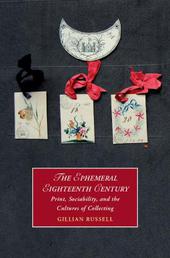
|
The Ephemeral Eighteenth Century: Print, Sociability, and the Cultures of Collecting
Hardback
Main Details
Description
Often regarded as trivial and disposable, printed ephemera, such as tickets, playbills and handbills, was essential in the development of eighteenth-century culture. In this original study, richly illustrated with examples from across the period, Gillian Russell examines the emergence of the cultural category of printed ephemera, its relationship with forms of sociability, the history of the book, and ideas of what constituted the boundaries of literature and literary value. Russell explores the role of contemporary collectors such as Sarah Sophia Banks in preserving such material, arguing for 'ephemerology' as a distinctive strand of popular antiquarianism. Multi-disciplinary in scope, The Ephemeral Eighteenth Century reveals new perspectives on the history of theatre, the fiction of Maria Edgeworth and Jane Austen, and on the history of bibliography, as well as highlighting the continuing relevance of the concept of ephemerality to how we connect through social media today.
Author Biography
Gillian Russell is Professor of English at the University of York. A Fellow of the Australian Academy of the Humanities, she is internationally renowned for her innovative interdisciplinary research that began with The Theatres of War: Performance, Culture and Society, 1793-1815 (1995). She has pioneered field-changing new directions in scholarship - on war and theatre and on the study of sociability. Her books include Romantic Sociability: Social Networks and Literary Culture 1770-1840 (Cambridge, 2002), co-edited with Clara Tuite, Women, Sociability and Theatre in Georgian London (Cambridge, 2007), and Tracing War in British Enlightenment and Romantic Culture, co-edited with Neil Ramsey (2015).
Reviews'A comprehensive, interdisciplinary examination, Russell's admirable volume will resonate with those researching Romanticism, English literature, print and publishing history, material culture, and the history of collecting. Twenty-four illustrations; a stunning bibliography of collections, primary, and secondary sources; and a thorough index enhance the volume's significance.' J. Decker, Choice
|